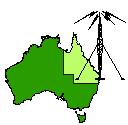 QUEENSLAND
DIGITAL GROUP
QUEENSLAND
DIGITAL GROUP
 QUEENSLAND
DIGITAL GROUP
QUEENSLAND
DIGITAL GROUP
Home
ATV
Committee
Computer
Digipeat
Downloads
For Sale
Help
Information
IP subnets
Links Latest Information
Membership
Modem
Modem Help Desk
Network and BBS
Network Map
NEWS Photo page VHF
Who is the QDG Wireless LAN
Site Index
Spam and Open Relay Blocking System
Detailed Modem Information
ADSL Cable Cable Links Dialup Satellite Wireless
Versions of these pages are also available at this site for those on the internal University of Queensland network.
The full links are given so you can cut and past without going to the site.
Expected ADSL speeds
256/64 = above 20KBytes p/s
512/128 = above 40KBytes p/s
1500/256 = above 120KBytes p/s
Standard analogue telephone lines can only transmit raw data
at around 3430bps.
Some telcos only guarantee their lines for 28.80bps.
Data compression raised the data speeds to 9600, 14,400, 28,800 and finally
33,600 baud.
33,600 baud was thought to be the absolute speed limit on modem transmissions
until two competing Digital Technology compression standards (X2 and KFLEX) were
created. These two standards were then replaced by V.90 and now V.92.
Both the V.90 and V.92 standards default to the fastest possible connection, but
impurities in the public switched telephone system may reduce the actual
throughput of the modem. Physical defects in the makeup of the telephone line,
electronic switching devices, filters, amplifiers etc, installed by the telco,
extension leads and even the weather can reduce the effective bandwidth
available to your modem.
Other devices (phones, fax and answer machines etc) sharing the modem line will
also have a negative effect on data bandwidth.
The client modem tries to detect these impairments during the initial connection
negotiation, if the line conditions change, the modem will retrain. A retrain
can be initiated at either end of the connection by a modem detecting lost or
corrupt data. During the initial connection "handshake", the host (ISP's) modem
negotiates with the client modem, testing the capabilities of the phone line, by
generating a DIL (Digital Impairment Learning) data burst. This "discovery" is a
V.8 DIL data burst.
This is the funny sounding "BONG" during a modem handshake. The "BONG" sound is
an equal mix of sound that is spread across 150 Hertz to 3750 Hertz. The client
modem will listen to the sound and try to locate the "bad spots" (noise or
static) or impairments and avoid placing data into them.
In most cases when a modem is losing data, it will train down. Line conditions
are dynamic and will vary during the call as well as from call to call. In a
case where a client modem makes an aggressive connection, there may be so much
noise on the telephone line that the modem spends a large portion of the time
re-sending data that was corrupted or damaged, or re-training to overcome this
condition. This is one of the causes of low throughput and disconnections if the
modems fail to renegotiate.
It is very common during peak telephone usage that a call to a number right next
door be routed across town, or to a different city and back. While this helps
the phone company deal with increased demand, it can create a
potential for low-quality modem connections.
The more expensive (than internal) external modems are usually better at coping with less than perfect phone lines, they also don't relay on the computer hardware and software to maintain the link.
Telcos that use their television cable network as part of their analogue phone network also introduce problems due to the bandwidth used, amplifiers, compression etc. client modems can often only obtain V34 (33.600baud) connections.
Please let me know if any of the links no longer work and any links you would like added.
NOTICE: always refresh your browser for
each page on this site. Changes
are frequent.
If you are visiting from another site, this is our address http://www.qdg.org.au/